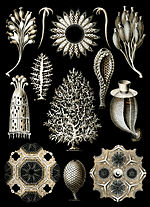Cards In This Set
| Front | Back |
|
Sponges
Rank 1
|
 -sea sponge, siliceous sponge, and sea sponge -Cellular level of organization (no true tissues) -Cells totipotent (capable of developing into a complete organism or differentiating into any tissue in the organism) -Choanocytes drive water through aquiferous system -Sessile suspension feeders -Some possess skeletal elements called spicules |
|
Cnidarians
Rank2
|
 -jellyfish, coral, hydra, and sea anemones -Possess ectoderm and endoderm (diploblastic) -Radial symmetry -Possess Cnidae (commonly called nematocysts or stinging cells) -Two-way gut -No head, central nervous system, discrete gas exchange, excretory or circulatory systems -Possess a nerve net |
|
Flatworms
Rank 3
|
 -tapeworms, flukes, and planaria -Unsegmented worms -Triploblastic, acoelomate -Bilateral symmetry -Complex but two-way gut -Cephalized nervous system -Possess primitive excretory and osmosregulatory structures -Typically hermaphroditic |
|
Roundworms
Rank 4
|
 -whipworms, hookworms, and pinworms -Triploblastic, bilateral, vermiform and pseudocoelomate -Body covered in cuticle which must be molted -Cephalic sense organs called amphids -Six lips with sense organs surround mouth -Unique excretory system but no special circulatory or gas exchange systems -Gonochoristic |
|
Annelids
Rank 5
|
 -bristle worm and earthworms -Schizocoelomate, bilaterally symmetrical -Segmented -Complete digestive tract with regional specialization -Closed circulatory system -Cerebral ganglion and ventral nerve cord -Paired, bundled setae on each segment |
|
Mollusks
Rank 6
|
 -snails, clams, octopuses, tusk shells, and chitons -Coelomate, bilaterally symmetrical (secondary asymmetry) -Principle body cavity a hemocoel -Mantle covers body (thickened epidermis which secretes the shell, when present) -Shell made of calcareuos material -Muscular foot -Buccal region with radula -Complete gut |



